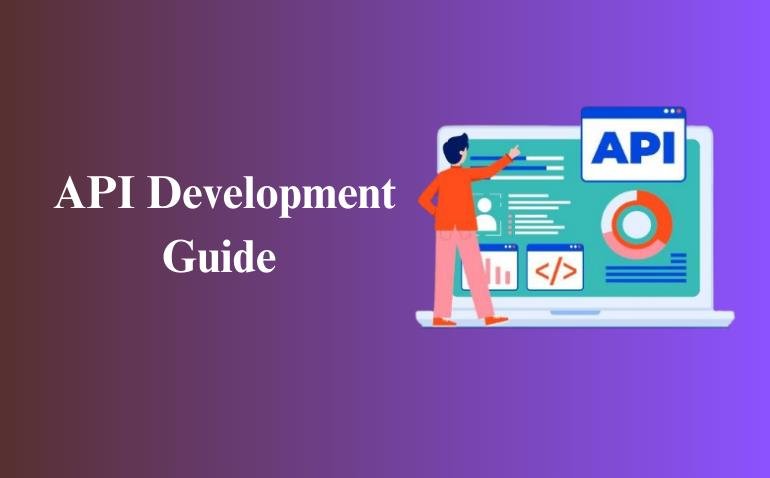Table of Contents
API Development Guide: A Complete Roadmap for Beginners and Professionals
Introduction
In the modern digital ecosystem, APIs (Application Programming Interfaces) are the invisible engines that power most of the technologies we use daily. When you order food through a mobile app, the restaurant’s system communicates with a delivery service using APIs. When you integrate PayPal or Stripe for payment processing, your website is calling secure APIs to handle transactions. When you log into an app using Google or Facebook, APIs are authenticating your credentials.
In short, APIs are the glue that connects applications, devices, and services. Without APIs, today’s software-driven world would not exist.
This API development guide aims to serve as a complete roadmap for anyone — from beginners who want to understand what APIs are, to experienced developers seeking to refine their approach. We’ll cover the entire lifecycle: planning, designing, coding, documenting, securing, testing, deploying, scaling, and maintaining APIs.
By the end of this guide, you will have the tools, frameworks, and best practices required to confidently build high-quality APIs that are secure, scalable, and developer-friendly.
Understanding APIs
What is an API?
An API is essentially a contract between two systems. It defines how one piece of software can interact with another, specifying the allowed requests and the expected responses.
For example:
- A weather app calls an API to fetch current weather data.
- An e-commerce store integrates a shipping API to calculate delivery charges.
- A fitness app syncs with a smartwatch through a health API.
Instead of reinventing the wheel, APIs let developers reuse existing capabilities and focus on building new features.
Types of APIs
There are different types of APIs, each suited to different use cases:
- Open APIs (Public APIs): Accessible to anyone, often used by third-party developers. Example: Twitter API.
- Internal APIs: Hidden from the public, used to connect internal systems within an organization.
- Partner APIs: Shared with selected partners under contractual agreements. Example: APIs between Uber and Google Maps.
- Composite APIs: Allow multiple API calls to be combined into a single request. Useful for performance optimization.
Why APIs Matter
APIs are not just technical tools — they are strategic assets.
- Enable Innovation: APIs allow startups and enterprises to build new services rapidly by connecting with existing platforms. For example, fintech companies rely on APIs from banks and payment processors.
- Drive Efficiency: Automation becomes possible when different systems talk through APIs, reducing manual effort.
- Support Digital Transformation: Cloud services, IoT, artificial intelligence, and mobile applications are all powered by APIs.
- Generate Revenue: Many companies monetize APIs (e.g., Twilio for communications, Stripe for payments, Google Maps for geolocation).
The API Development Lifecycle
The API development guide would be incomplete without describing the lifecycle. Developing an API involves a sequence of well-structured steps:
- Planning – Define objectives, use cases, and target users.
- Design – Choose architecture (REST, GraphQL, gRPC, SOAP), define endpoints, and establish data models.
- Development – Implement logic, integrate databases, and handle authentication.
- Documentation – Create clear, developer-friendly references.
- Testing – Validate functionality, security, and performance.
- Deployment – Host APIs on cloud, containers, or serverless platforms.
- Monitoring & Maintenance – Track usage, handle scaling, and fix issues.
Designing APIs
Choosing an API Style
There are several architectural styles:
- REST (Representational State Transfer):
- Most popular, uses HTTP verbs (GET, POST, PUT, DELETE).
- Example endpoint:
GET /api/v1/users. - Lightweight and widely supported.
- GraphQL:
- Developed by Facebook.
- Clients can request exactly the data they need.
- Useful for apps with complex UI requirements.
- gRPC:
- High-performance, uses Protocol Buffers.
- Supports streaming.
- Great for microservices.
- SOAP:
- XML-based protocol, older but still used in banking and enterprise systems.
Best Practices in API Design
- Keep endpoints simple and intuitive (
/products,/users). - Use versioning (
/api/v1/). - Always return consistent data formats (usually JSON).
- Provide meaningful error codes and messages.
- Avoid over-fetching or under-fetching of data.
Security in API Development
Security is one of the most important aspects of this API development guide. Since APIs often expose critical business functions, they are prime targets for hackers.
Authentication and Authorization Methods
- API Keys: Simple tokens for identification, but limited security.
- OAuth 2.0: Industry-standard for third-party app access.
- JWT (JSON Web Tokens): Compact and secure tokens for user authentication.
Additional Security Measures
- HTTPS/TLS: Always encrypt communication.
- Rate Limiting: Prevent abuse by limiting requests per second.
- Input Validation: Block malicious inputs (SQL injection, XSS).
- CORS Policies: Restrict which domains can access your API.
Documenting APIs
Even the most powerful API will fail if developers cannot understand it. Documentation is your product’s instruction manual.
Tools for Documentation
- Swagger/OpenAPI: The most popular framework for REST APIs.
- Postman Collections: Interactive way to share endpoints.
- Redoc: Beautiful API documentation generator.
Key Elements of Documentation
- Endpoint descriptions.
- Request and response examples.
- Authentication instructions.
- Error codes and troubleshooting.
- Rate limits and usage guidelines.
Testing APIs
Testing ensures your API works as expected under different conditions.
Types of Testing
- Unit Testing: Verifies small components individually.
- Integration Testing: Checks whether different systems work together.
- Load Testing: Measures performance under heavy usage.
- Security Testing: Identifies vulnerabilities like broken authentication or SQL injection.
Popular Tools
- Postman for functional testing.
- SoapUI for SOAP and REST.
- JMeter for load testing.
- Newman for automated Postman test runs.
Deploying APIs
Once tested, your API must be deployed so others can access it.
Hosting Options
- Cloud Providers (AWS, Azure, GCP): Offer scalability and reliability.
- Containers (Docker, Kubernetes): Provide portability and microservices orchestration.
- Serverless (AWS Lambda, Azure Functions): Ideal for event-driven, cost-effective deployments.
CI/CD Pipelines
- Automate builds, testing, and deployments.
- Ensure smooth and frequent releases.
- Enable rollback in case of issues.
Scaling APIs
When your API gains traction, scaling becomes critical.
Techniques for Scaling
- Horizontal Scaling: Add more servers to handle load.
- Vertical Scaling: Add more power to existing servers.
- Caching: Use Redis or Memcached to reduce database hits.
- Content Delivery Networks (CDNs): Deliver responses faster across geographies.
- API Gateways: Centralized traffic management, rate limiting, and analytics.
Versioning and Maintenance
APIs evolve over time, but backward compatibility is essential.
- Use versioning in URLs (
/v1/,/v2/). - Deprecate old versions gradually with warnings.
- Update documentation whenever new features are added.
- Monitor logs and analytics to identify usage trends and potential issues.
Common Challenges in API Development
- Poor Documentation: Makes adoption difficult.
- Inconsistent Standards: Leads to confusion among developers.
- Performance Bottlenecks: Can frustrate users and partners.
- Security Flaws: A major risk if not addressed early.
- Complex Integrations: APIs should aim to simplify, not complicate.
Real-World Examples of API Usage
- Stripe API: Handles billions of transactions securely.
- Twilio API: Powers SMS, calls, and video communication.
- Google Maps API: Used in ride-sharing apps, delivery platforms, and location-based services.
- Spotify API: Allows developers to build music recommendation apps.
These examples show how APIs can unlock new business opportunities.
Future of APIs
The role of APIs will only grow in the future. Trends include:
- AI-Powered APIs: Providing intelligent services such as machine learning predictions.
- API-First Development: Designing APIs before building applications.
- Edge APIs: Running closer to the user for low-latency performance.
- Standardization Efforts: Making APIs more interoperable across industries.
Conclusion
This API development guide has covered the entire journey of building APIs: understanding the basics, designing endpoints, securing communication, writing documentation, testing performance, deploying to the cloud, and scaling for millions of users.
APIs are not just technical artifacts — they are strategic enablers of innovation and growth. Whether you’re a beginner creating your first REST API or an experienced engineer building microservices at scale, mastering API development will give you a powerful advantage in today’s software-driven world.
By following the best practices outlined here, you’ll be able to design and deliver APIs that are reliable, secure, and developer-friendly.


